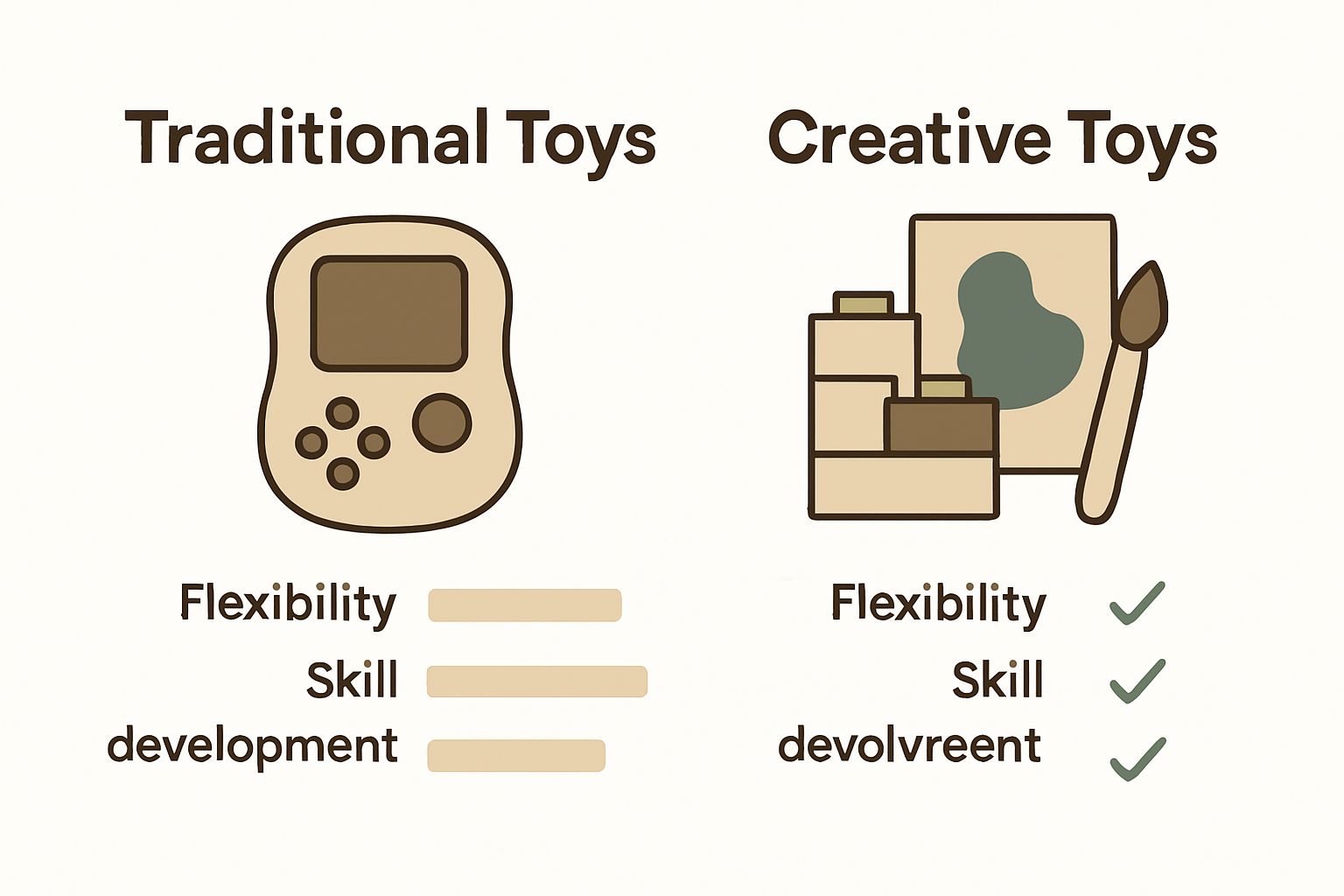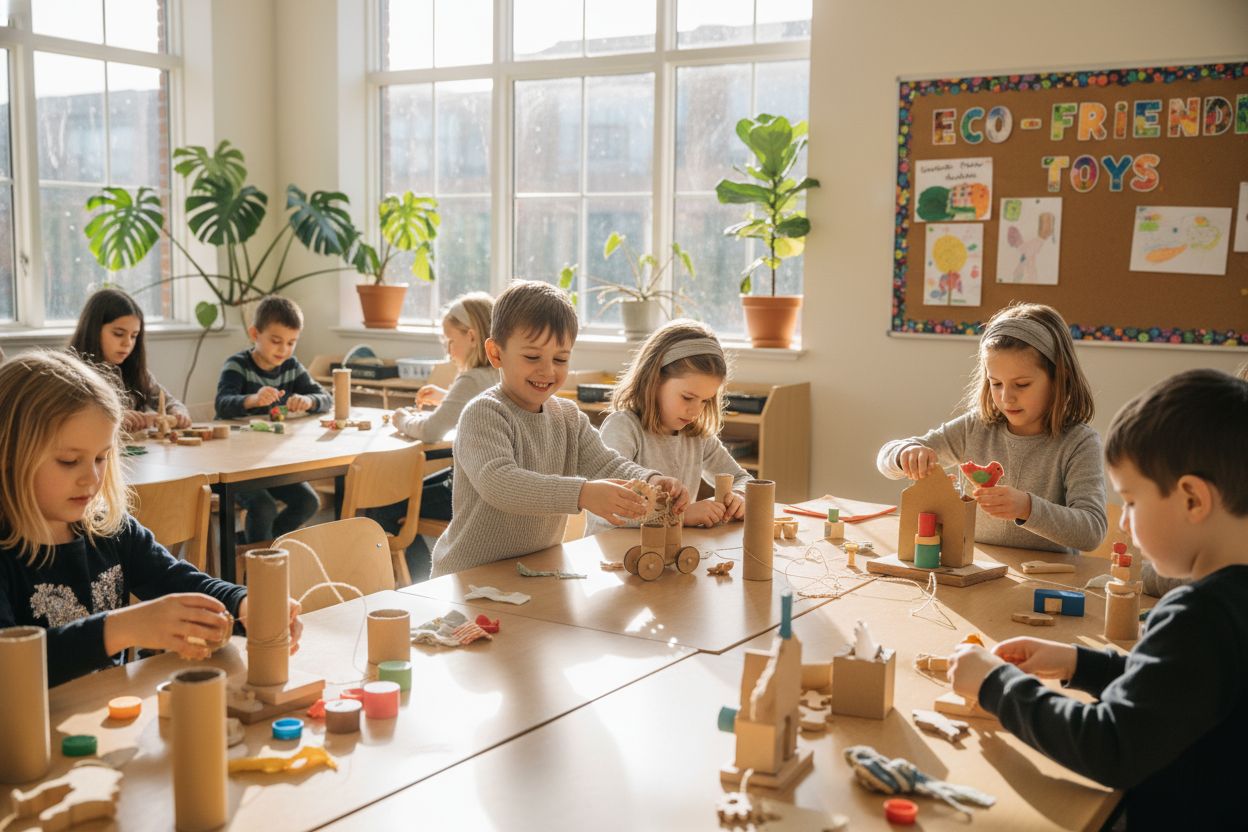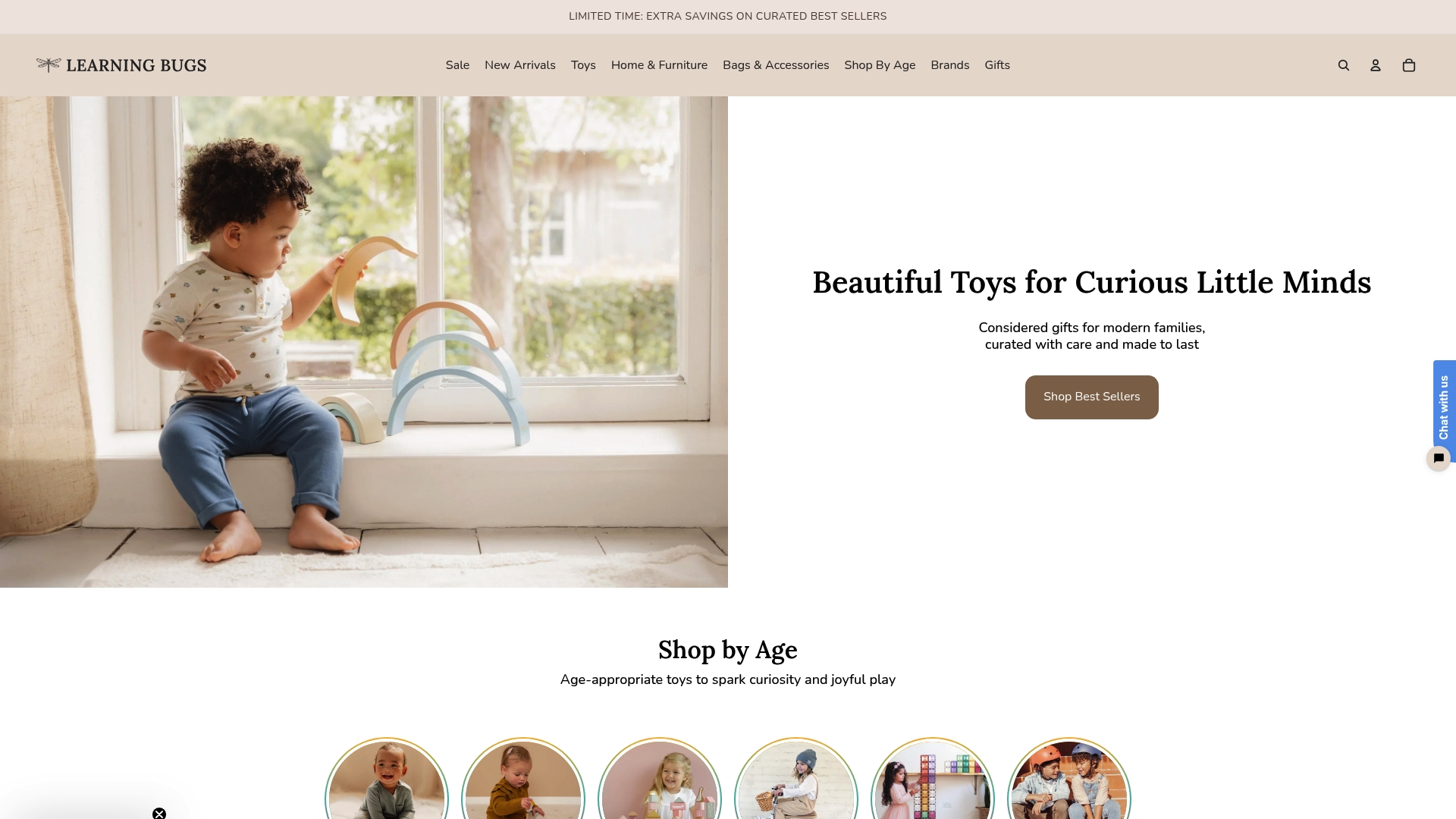Creative toys do much more than keep children occupied. These playthings drive real growth and discovery, with over 40 million tonnes of plastic waste produced by the global toy industry every year. It sounds counterintuitive, but the toys chosen today shape not just young minds, but the planet’s future as well.
Table of Contents
- What Are Creative Toys And Why Do They Matter?
- The Role Of Creativity In Child Development
- How Creative Toys Enhance Learning And Skills
- Understanding The Emotional Benefits Of Creative Play
- Why Choosing Eco-Friendly Creative Toys Is Important
Quick Summary
| Takeaway | Explanation |
|---|---|
| Creative toys foster imaginative play. | These toys encourage children to explore and innovate, stimulating their imagination and creativity through unstructured play experiences. |
| They enhance cognitive and emotional skills. | Creative toys support the development of critical thinking, problem-solving abilities, and emotional intelligence in young children. |
| Creative play builds psychological resilience. | Engaging in imaginative scenarios helps children learn to navigate complex emotions and manage uncertainties, fostering emotional coping skills. |
| Eco-friendly toys educate on sustainability. | Choosing environmentally conscious toys teaches children valuable lessons about resource conservation and environmental stewardship while they play. |
| Multifunctional designs promote varied play scenarios. | Creative toys are designed to allow multiple ways of playing, encouraging independence and self-directed exploration in children. |
What are Creative Toys and Why Do They Matter?
Creative toys represent far more than simple entertainment. These carefully designed playthings are powerful developmental tools that stimulate a child’s imagination, cognitive growth, and sensory exploration. Learn more about developmental toys that support children’s holistic learning experiences.
Understanding Creative Toys
Creative toys are specialised play objects engineered to encourage open-ended exploration, problem solving, and imaginative thinking. Unlike traditional toys with predetermined outcomes, these playthings invite children to experiment, construct, and discover through unstructured play. Their design typically incorporates elements that challenge children to think critically, make decisions, and express themselves uniquely.
The following table summarises the key characteristics of creative toys as described in the article, helping to clarify what sets them apart from traditional toys.
| Characteristic | Description |
|---|---|
| Multifunctional design | Allows for multiple play scenarios, encouraging adaptability and creative thinking |
| Sensory-engaging materials | Incorporates materials that stimulate different senses, enhancing exploratory play |
| Promotes problem solving | Challenges children to independently solve problems during play |
| Supports independent exploration | Enables self-directed, child-led discovery |
| Open-ended play | Does not impose predetermined outcomes, fostering imagination and innovation |

Key characteristics of creative toys include:
- Multifunctional design allowing multiple play scenarios
- Materials that stimulate sensory engagement
- Elements promoting independent problem solving
- Opportunities for child-directed exploration
The Developmental Impact
Research from Child Development Perspectives demonstrates that creative toys play a crucial role in cognitive and emotional development. By providing open-ended play experiences, these toys help children develop critical thinking skills, emotional intelligence, and spatial reasoning.
Creative toys work by presenting children with opportunities to:
- Experiment without fear of failure
- Create unique solutions to play challenges
- Develop fine and gross motor skills
- Express emotions through non-verbal play
Through thoughtful interaction with creative toys, children build confidence, learn complex problem-solving techniques, and discover their innate potential for innovation and imagination.
This table compares the developmental impacts creative toys have across various domains, demonstrating how play supports broad aspects of child growth as referenced in the content.
| Developmental Domain | Impact of Creative Toys |
|---|---|
| Cognitive Skills | Enhances critical thinking, problem solving, spatial reasoning, and pattern recognition |
| Emotional Intelligence | Fosters self-awareness, empathy, and emotional regulation |
| Social Skills | Encourages communication, perspective-taking, and interaction with others |
| Psychological Resilience | Builds coping mechanisms, emotional flexibility, and the ability to manage uncertainty and complex feelings |
| Environmental Awareness | Teaches resource conservation, sustainability, and ecological responsibility through use of eco-friendly toys |
The Role of Creativity in Child Development
Creativity serves as a foundational skill that transforms how children perceive, interact with, and understand their environment. Discover age-appropriate developmental toys that nurture this essential cognitive capability.
Creativity as a Cognitive Process
Beyond artistic expression, creativity represents a complex cognitive process involving imagination, problem solving, and innovative thinking. According to developmental psychology research, creativity enables children to develop neurological pathways that support advanced reasoning and adaptability.
Key cognitive benefits of creative engagement include:
- Enhanced neural connectivity
- Improved abstract thinking capabilities
- Greater mental flexibility
- Increased capacity for complex reasoning
Developmental Significance
Creative experiences fundamentally shape neural architecture during critical developmental windows. Children who regularly engage in creative activities demonstrate improved cognitive resilience and enhanced learning potential. These experiences help children transform theoretical knowledge into practical understanding, enabling them to approach challenges with curiosity and confidence.
Research indicates that creative activities support multiple developmental domains:
- Emotional intelligence and self-expression
- Social interaction and communication skills
- Intellectual curiosity and exploratory behaviour
- Psychological adaptability and stress management
By providing environments that encourage creative exploration, parents and educators can significantly influence a child’s cognitive and emotional development, preparing them for future learning challenges.
How Creative Toys Enhance Learning and Skills
Creative toys are sophisticated learning instruments that go beyond traditional play, serving as powerful mechanisms for skill development. Explore our educational toy collections to understand how play transforms learning experiences.
Cognitive Skill Development
Creative toys function as intricate educational tools that stimulate multiple cognitive domains simultaneously. According to developmental neuroscience research, these toys trigger complex neural interactions that support advanced learning processes.
Key cognitive skills enhanced through creative play include:
- Problem solving abilities
- Spatial reasoning capabilities
- Pattern recognition skills
- Critical thinking development
Multidimensional Learning Mechanisms
The interaction with creative toys generates profound neurological engagement. Children do not merely play; they construct mental frameworks that translate sensory experiences into meaningful understanding. This process involves integrating visual, tactile, and cognitive inputs, which helps build comprehensive learning pathways.
Skill enhancement occurs through:
- Hands-on experimentation
- Open-ended exploration
- Independent decision making
- Imaginative scenario construction
Through strategic play, children transform abstract concepts into tangible understanding, developing foundational skills that extend far beyond immediate playtime interactions.
Understanding the Emotional Benefits of Creative Play
Creative play represents a profound emotional learning experience that extends far beyond simple entertainment. Explore emotional development resources to understand how play supports children’s inner world.
Emotional Intelligence Development
Emotional intelligence emerges through playful interactions that challenge children to recognise, understand, and navigate complex feelings. According to child psychology research, creative play provides a safe environment for emotional exploration and self-expression.
Key emotional skills cultivated during creative play include:
- Self-awareness and emotional recognition
- Empathy and perspective-taking
- Emotional regulation strategies
- Confidence in expressing feelings
Psychological Resilience Through Play
Creative play acts as a psychological training ground where children develop emotional coping mechanisms. By engaging in imaginative scenarios, children learn to process complex emotions, manage uncertainties, and build emotional flexibility. These experiences help children transform potentially overwhelming feelings into manageable, comprehensible experiences.
Emotional growth occurs through:
- Symbolic representation of feelings
- Safe emotional experimentation
- Understanding emotional cause and effect
- Building emotional vocabulary
Through strategic, creative play, children develop a nuanced understanding of their inner emotional landscape, preparing them for more complex social and personal interactions.
Why Choosing Eco-Friendly Creative Toys is Important
Eco-friendly creative toys represent a conscientious approach to children’s play that balances developmental needs with environmental responsibility. Discover sustainable craft kits that transform play into an environmentally conscious experience.
Environmental Impact of Toy Production
Traditional toy manufacturing generates significant ecological consequences, consuming substantial natural resources and producing considerable waste. According to environmental sustainability research, the global toy industry contributes approximately 40 million tonnes of plastic waste annually, with most products taking hundreds of years to decompose.
Key environmental challenges in toy production include:
- High carbon emission during manufacturing
- Non-biodegradable material usage
- Excessive plastic packaging
- Limited recycling opportunities
Sustainable Play and Child Development
Eco-friendly toys offer more than environmental benefits. These consciously designed playthings introduce children to sustainable living concepts from an early age. By engaging with responsibly produced toys, children learn valuable lessons about resource conservation, material lifecycle, and environmental stewardship.
Benefits of choosing eco-friendly creative toys encompass:
- Reduced environmental footprint
- Teaching ecological awareness
- Supporting sustainable manufacturing practices
- Encouraging mindful consumption
Through intentional toy selection, parents can transform playtime into a meaningful educational experience that nurtures both child development and environmental consciousness.
Below is a table outlining the main environmental challenges associated with traditional toy production and the benefits of choosing eco-friendly creative toys, as highlighted in the article.
| Aspect | Traditional Toy Production | Eco-Friendly Creative Toys |
|---|---|---|
| Material Use | Mainly non-biodegradable plastics | Sustainable, often biodegradable or recycled |
| Environmental Footprint | High carbon emissions, large-scale waste | Reduced emissions and waste |
| Packaging | Excessive plastic | Minimal, eco-conscious packaging |
| Educational Value | Limited focus on environmental stewardship | Promotes sustainability and ecological awareness |
| Recycling Opportunities | Limited | Greater potential for recycling and reusing |

Give the Gift of Imagination with Creative Toys
Modern parents often struggle to find toys that truly nurture imagination and meaningful development. If you are searching for a gift that supports emotional intelligence, problem solving, and creativity—as discussed throughout this article—then it’s time to explore toys that make playtime both joyful and educational. Unlock the benefits of creative play and choose toys that help children thrive now and long into the future. Discover how play transforms learning experiences.

Ready to make gift-giving impactful? Shop the curated selection at Learning Bugs where every toy is designed to foster cognitive growth and imaginative play. Browse by age, type, or brand to find something special for every child. Act now to inspire a lifetime of joyful, intelligent play—visit our main site and choose gifts that matter.
Frequently Asked Questions
What are creative toys?
Creative toys are specially designed playthings that encourage open-ended exploration and imaginative thinking, allowing children to experiment and solve problems without predetermined outcomes.
How do creative toys impact child development?
Creative toys significantly enhance cognitive and emotional development by promoting skills such as critical thinking, emotional intelligence, and spatial reasoning through unstructured play experiences.
Why are eco-friendly creative toys important for children?
Eco-friendly creative toys not only reduce environmental impact but also teach children about sustainability and resource conservation, instilling ecological awareness from a young age.
How can parents encourage creative play with toys?
Parents can support creative play by providing a variety of open-ended toys, allowing children to explore freely, and engaging in play with them, which fosters imaginative thinking and enhances learning experiences.

0 comments